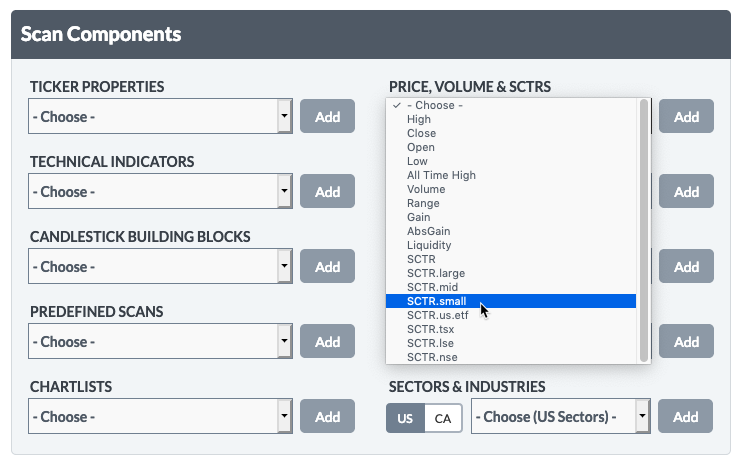Table of Contents
Scanning for SCTRs
The StockCharts Technical Rank (SCTR) is a numerical score based on six key indicator values, which is used to rank a stock or other security within a group of its peers. StockCharts currently offers SCTR rankings based on a number of groups, from US small-cap stocks to ETFs to London Stock Exchange securities. While not every security receives a SCTR ranking, scanning for SCTRs can be a great way to discover securities that are doing better than their peers across six important technical measurements.
To learn more about what SCTR “universes” (groups) are available and how the SCTR score is calculated for each security, check out our ChartSchool article on SCTRs.
Adding SCTR Clauses to Your Scan
In the Advanced Scan Workbench, SCTR clauses can be added from the “Price, Volume & SCTRs” dropdown menu in Scan Components.

The general format for SCTR scan clauses is as follows:
[SCTR.large > 90]
SCTR values range from 0.0 to 99.99, with stocks over 90 being the strongest in the group and stocks under 10 being the weakest. The clause above looks for the strongest stocks in the US large-cap SCTR universe.
In addition to the SCTR clauses for specific universes, there is also a SCTR clause that does not specify a universe:
[SCTR > 90]
This clause looks for the strongest securities across all SCTR universes. This will include US, Canada, London and India stocks, as well as US ETFs. When using this clause, you may want to include additional clauses to limit the universe, as seen in the example below (which restricts the scan to US securities):
[country is US] and [SCTR > 90]
It's All Relative
Remember, the SCTR score is a relative measurement, comparing that stock to other stocks in the specified group. It does not make any claims about how the group as a whole is doing. If small-cap stocks are performing poorly across the board, then having a SCTR score of 90 in that small-cap universe is not as impressive as having the same SCTR score in a group that is performing well.
Relativity matters within a single SCTR universe too. If the group as a whole has poor performance, and one stock simply stayed at the same level of performance, then that stock's SCTR rank will actually go up relative to the other stocks in that universe. Just because a stock's SCTR rank goes up does not mean that it is performing well - merely that it is not performing as poorly as the others.
As a result, while the SCTR value will quickly and easily show you the relative strength or weakness within a group, it is important to make sure the stock is doing well in absolute terms too. You can do this by adding clauses to determine if the stock is in an uptrend, if its MACD score is favorable, etc.
Example SCTR Scans
While the SCTR scan clause examples we've seen so far have focused on finding SCTR values above a specified level, the entire spectrum of scan syntax is available in SCTR scans. Here are just a few examples:
Cross Operator
Using the cross operator to find Toronto stocks with a SCTR crossing above 70 today:
[SCTR.tsx x 70]
Arithmetic Operator
Using arithmetic operators to look for mid-cap stocks whose SCTR has gone up more than 20 today:
[today's SCTR.mid > [yesterday's SCTR.mid + 20]]
OR Clauses
Using OR clauses to look for stocks with high SCTR values across three different universes:
[ [SCTR.large > 90] or [SCTR.mid > 90] or [SCTR.small > 90] ]
Max() Function
Using the Max() function and date modifiers to find London stocks with a 6-month high SCTR value:
[today's SCTR.lse > yesterday's max(120,SCTR.lse)]
Simple Moving Average
Using the simple moving average (SMA) indicator to find ETFs with a consistently high SCTR over the last 50 trading days:
[SMA(50,SCTR.us.etf) > 90]
Conclusion
SCTR scan clauses are a good way to narrow down your scan to stocks performing at the top of their group. Because SCTR rankings incorporate six different performance measurements across three different timeframes, they help you quickly determine the overall performance of a security relative to its peers. However, because the SCTR is a relative ranking, these scan clauses should not be used by themselves. For best results, be sure to include other, non-relative, scan clauses along with the SCTR clause.